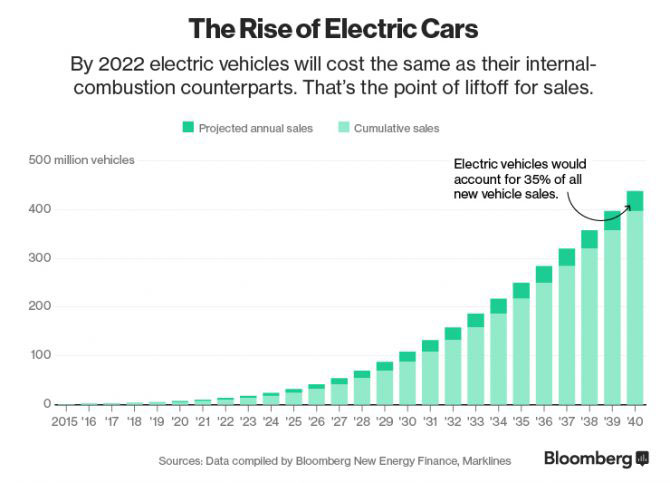In the United States, electric vehicles are increasingly dominating the alternative fuel market for passenger vehicles. Despite a decrease in sales in 2015 over the previous year, EV sales are on the rise in 2016, with annual gains of up to 31% posted through November. Popular manufacturers like Tesla and Chevy are leading the pack, but there are now 30 different models from dozens of manufacturers to choose from, a dramatic increase from the nine models available in 2012.
While electric car sales still represent less than 1% of total car sales annually in the U.S., many groups including Bloomberg New Energy Finance (BNEF) are predicting widespread global adoption over the next decade, with electric vehicles reaching price parity with internal combustion vehicles as early as 2022. According to BNEF’s predictions, electric vehicles will account for 35% of all global vehicle sales (over 400 million) by 2040, potentially even causing an oil crash.

With this boom in electric vehicle sales, we wondered how other alternative fuel vehicle options fairing? Is there still a place for hybrid, natural gas and hydrogen fuel cell vehicles in the passenger vehicle market?
Hybrids
While hybrid sales are down over 14% in the U.S. this year, hybrids remain the leader in the alternative fuel vehicle market overall. In fact, over the past three years, hybrids accounted for nearly 80% of all alternative powertrain purchases in the American market.
While few people are predicting an end to hybrid technology anytime soon, there are several trends that are challenging the future of hybrid sales. The first is low gas prices. Here, leading hybrid manufacturers like Toyota are putting more effort into the development of hybrid SUVs and trucks, as large vehicle sales typically increase in the U.S. when gas prices are low.
Second, efficiency of standard gasoline vehicles is rapidly increasing, with many models now offering as much as 35mpg. If the Obama administration’s new Corporate Average Fuel Economy (CAFE) standards — requiring automakers to raise the average fuel efficiency of new cars and trucks to 54.5 miles per gallon by 2025 — hold in the new administration, this may further challenge the hybrid market, given the cars higher price tags.
Finally, EV sales are increasing. As ranges significantly increase, buyers are more willing to take the leap to EV. All of this said, we expect hybrids to maintain an important place in the market for a while to come, particularly given demand in countries where gas prices have not fallen as low and demand remains steady.
Compressed Natural Gas (CNG)
Given the high cost of building natural gas fueling stations — $45,000 to as much as $1.8 million, according to the Department of Energy (DOE) — natural gas has not taken off in the passenger vehicle market in the U.S. and is unlikely to do so anytime soon. According to the DOE, there are only 960 privately operated CNG stations the U.S. By contrast, you can charge an EV at 14,815 charging stations or 38,183 charging outlets.
Honda, the only manufacturer to offer a CNG-only passenger vehicle in the U.S., saw consistent declines in sales since introducing the vehicle in 2008/2009, and has since pulled the plug on new production for the U.S. market. Bi-fuel or flex-fuel vehicles, particularly light and medium duty trucks, have fared better, and are still available from manufacturers such as Ford.
The medium- and heavy-duty fleet sector, which had been the bright spot for CNG growth in the U.S., has also slowed significantly in 2016, but infrastructure development continues and some companies are hedging their bets on a CNG resurgence in the not too distant future.
Interestingly, sales of passenger CNG vehicles continue to rise in Europe, and projections look promising in South America and the Asia Pacific regions as well, signaling even greater relevance globally. As with hybrids, higher gas prices and tougher emissions standards in other countries keep CNG vehicles a relevant concern for vehicle manufacturers.
Hydrogen Fuel Cell
The future of hydrogen fuel cell vehicles is a point of hot debate. Elon Musk, CEO of Tesla, is perhaps one of the most vocal and well-known critics of the technology, calling hydrogen fuel cell vehicles “extremely silly” and “an incredibly dumb” alternative fuel. At the same time, the DOE launched H2USA, a public-private partnership with fuel cell electric vehicle OEMs focused on advancing hydrogen infrastructure to support more transportation energy options for drivers. Manufacturers including Toyota, Hyundai and Honda are making new models for the California market, the first market to offer the vehicles for commercial sale. Finally, refueling station infrastructure investments continue to be made in California and new stations are planned for Connecticut, Massachusetts and New York.
Hydrogen fuel cell vehicles use hydrogen gas combined with oxygen to produce electricity, which runs the motor. While the production of hydrogen fuel remains inefficient compared to other alternative fuels (one of the main criticisms against the technology) and generates emissions at the generation source, hydrogen fuel cell technology emits only water vapor and warm air as exhaust, making it an attractive alternative to consider. Hydrogen can also be produced domestically from resources like natural gas, coal, solar energy, wind and biomass, a plus for energy security. But with only a few thousand vehicles in active operation in California, the verdict is still out as to whether hydrogen fuel cell vehicles will remain a relevant concern.
In summary, while EV sales are taking off and are seen by many as the future of alternative vehicles in the U.S., it is truly too early to tell. Nearly all of the vehicle technologies and the associated infrastructure needed to support them are in the early stages of development, and technological advancements and financial investments are occurring at a rapid pace. As a one-size-fits-all approach rarely solves a complex problem, we suspect the future holds space for many of these technologies, as well as others yet discovered.
